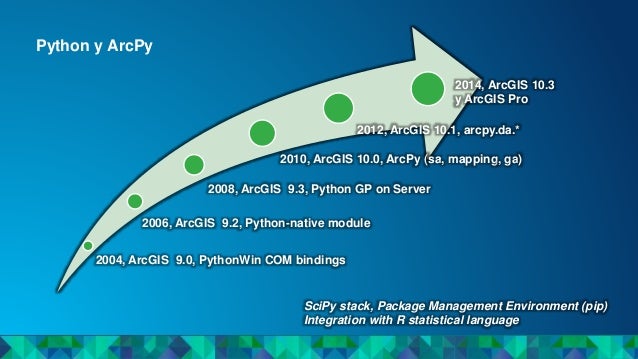

If you are using a different version of ArcGIS, or if ArcGIS installed Python to a different folder, you may need to modify the instructions below to fit your directory. Confirm that ArcGIS 10.3.1 (or whatever version you're using) has installed Python to the folder C:\Python27\ArcGIS10.3\ by confirming this folder exists, and that python.exe exists within it.
#Arcgis 10.3 python download

This tutorial will assume that you have ArcGIS 10.3.1 installed on your computer, but the tutorial should apply to other versions of ArcGIS as well. ArcGIS must be installed on your computer.This tutorial will go through the steps to set up your machine to run Python scripts that can successfully lauch the proprietary arcpy module and any other Python modules that may be useful in your scripts. Finally, my experience is that ArcGIS commands executed using Python codes run much faster, and throw mysterious error messages far less often.Ī disadvantage of running ArcGIS using Python and arcpy is that is can be a little tricky to set up.
#Arcgis 10.3 python code
Python code is ideal for simply executing repeated commands using loops or, even better, parallelized operations across multiple computer cores. Writing iterative loops in Model Builder is confusing, and it is not possible to write multiple nested loops. Model Builder also provides a record of your work however, it comes with some disadvantages. Unlike manually executing toolbox commands in ArcMap, scripting in Python provides a record of your work, which you can return to to edit or check your work. There are many advantages to using arcpy, rather than manually executing commands in ArcMap or using ArcMap's Model Builder. Arcpy is a proprietary Python module that allows ArcGIS toolbox commands to be implemented through simple Python commands.

#Arcgis 10.3 python how to
This is a brief tutorial for how to get started scripting ArcGIS commands in Python using Arcpy. In the upcoming entries we will talk about creating density maps based on this type of grids so keep an eye!.Scripting with ArcGIS and Python using Arcpy These grids are very useful to create density maps for species spotted, mortality rates, etc.

To create a fishnet grid using ArcGIS 10, let’s follow the next steps: With ArcGIS you have the possibility of creating a fishnet of rectangular cells and the output can be polyline or polygon features. Route Analysis – finding the shortest path.Using ESRI products, Carto, Mapbox and Google Maps.


 0 kommentar(er)
0 kommentar(er)
